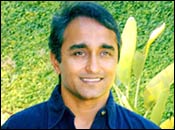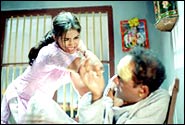 As a nephew of the legendary Sivaji Ganesan and a member of his household, it was only natural that Dharan Mandrayar would be attracted to films. Though he grew up assisting Sivaji Productions, his parents wanted him to be away from this line of work. To fulfil their desire to see him become a doctor, he went to study medicine at the Manipal Medical College in Karnataka. But just two months later, Dharan was back, saying he didn't want to be a doctor.
As a nephew of the legendary Sivaji Ganesan and a member of his household, it was only natural that Dharan Mandrayar would be attracted to films. Though he grew up assisting Sivaji Productions, his parents wanted him to be away from this line of work. To fulfil their desire to see him become a doctor, he went to study medicine at the Manipal Medical College in Karnataka. But just two months later, Dharan was back, saying he didn't want to be a doctor.
"Dropping out of medical school was my first rebellion," he remembers.
Soon, he was packed off to the United States to study. Owing to parental pressure, he took an undergraduate degree in science and later did his master's in business administration. Far away from the world of films, he led the life of an unknown corporate executive for a while.
| |||||||||||
His second feature film is White Rainbow, on the plight of the widows of Brindavan. It stars Sonali Kulkarni and Virendra Saxena.
Dharan, who lives in the US, was in Chennai in connection with a screening of the film. The Guild of Service had arranged a special show, which was also attended by Prime Minister Manmohan Singh's wife.
Dharan spoke to Shobha Warrier about White Rainbow. Excerpts:
Why the name
White Rainbow?White, because widows are forced to wear white. But I feel they still have a lot of life and colour in them. That's why the title, White Rainbow.
Did you have to think a lot before zeroing in on the title?
I wrote down whatever came to mind. I had a bunch of names. White Rainbow was on it, and as I went through it again and again, I found it appropriate. I think there is a term called 'white rainbow'. After a fog, the rainbow appears grey and people call it a white rainbow. But in reality, there is no such thing as a white rainbow. Rainbows are full of colours.
 What drove you to make a film on the widows of Brindavan? Does it have anything to do with Deepa Mehta's controversial film,
What drove you to make a film on the widows of Brindavan? Does it have anything to do with Deepa Mehta's controversial film,
Till I started my research to write the story, I was not aware of Deepa Mehta's Water. It was in December 2002 that I happened to read a story in my son's sixth standard book. It was about the sad plight of a young girl who was abandoned in a place called Brindavan, and how she came out of it.
The story disturbed me, and soon I was reading more about the widows of Brindavan. I saw many articles on them on the Internet. I also realised that the story that was in my son's book was written for children, and it didn't have the horror that actually takes place in the lives of those young widows.
I was not aware of this. When I spoke to my friends, they were also unaware of it. I lived in India till I was 21, and I keep coming here. But I had no idea that such a situation existed. So I thought people should know about this.
Was it pity for those women that drove you to make such a film?
The fact that they [the widows] are condemned and marginalised for no fault of theirs made me sad. It is not their fault that their husbands die, but they are branded inauspicious, unlucky, and are shunned by society.
After doing the research, did you go to Brindavan and meet any widows?
Yes. I went to Brindavan and wandered around the streets. I went to the various ashrams there. To put it mildly, Brindavan is not a clean city. To see those women sitting on the streets or lying in some corners was shocking and disturbing. To a passing eye, they may look like beggars. But to me, having read all about them, I could see anguish in their eyes. They were from UP [Uttar Pradesh], Bengal, and Bihar.
 Did you interact with them?
Did you interact with them?
They were not willing to talk to me, but their faces and eyes told a thousand stories.
Was it because you were a stranger or because you were a male that they refused to talk to you?
Both. Maybe because their lives are, in a way, dominated by men even there. Maybe they don't trust men as much as they trust women.
Later, my wife Linda went with Mohini Giri of Guild of Service (they run a home in Brindavan) to Brindavan and she could interact with them.
The real scripting started after our meeting with Mrs Giri and one of our actors, Virendra Saxena, who is also from Brindavan. Scripting became easy for me after my interaction with them. I didn't want to lie or overtly dramatise anything. I didn't want to sensationalise or shock people. I just wanted to tell them the truth. But at times, the truth was stranger than fiction.
Statistics say there are about 10,000 or 15,000 widows in Brindavan, a very small town.
Is the film from an outsider's point of view?
No. The protagonist Priya [played by Sonali Kulkarni] is from an affluent, educated family. But when she loses her husband in an accident soon after marriage, her in-laws blame her for their son's death. She is told to go to Brindavan or Kashi like all widows.
She didn't know till then that widows went to Kashi and Brindavan. A depressed Priya tries to commit suicide, but is rescued. She feels she has been spared death because she is expected to do something for the marginalised widows. So she goes to Brindavan and tries to help other women come out of their traumatic life.
 Did you at any point of time fear that you also would face opposition from people, like Deepa Mehta did?
Did you at any point of time fear that you also would face opposition from people, like Deepa Mehta did?
No. We learnt a lesson from her experience. We never created any noise when we were ready to make the film. We did everything silently.
We were keen on shooting with sync sound. But when I went to Brindavan, I realised that there was no way I could do that, as it was too loud and noisy. It's a very, very bustling city.
So, we created the streets of Brindavan in AVM Studios in Chennai. Of course, we shot a lot of Brindavan which did not require any sound.
On the whole, we had planned a 41 day shooting schedule. But we finished in 25 days.
Why did you decide to cast Sonali Kulkarni?
When we were trying to cast somebody in the protagonist's role, the obvious names that came to our mind were Tabu and Nandita Das. But we didn't want to typecast the film as art or commercial because of the cast. We tried to look beyond that. Ramu [Ram Kumar, Sivaji Ganesan's son] gave me some names and I went on a casting trip to Mumbai.
When I first met Sonali, she seemed to have the right combination of confidence, sophistication, and vulnerability the character needed. So we offered her the role, and the script to read. She called back in tears after reading the script and said she had to do it. I am very happy I cast her. She did a great job as Priya.
You decided to make the film in Hindi, not English. Which market were you targeting, Indian or overseas?
Both. My characters are from Bengal, UP, and Bihar, so they speak Hindi in their dialect. But the protagonist narrates the story in Hindi for the Indian audience. She does the same in English for the English version that we will market overseas. The rest of the film will be subtitled for the overseas market.
We decided on English subtitles as it would sound very stilted if those women, who are from the rural parts of India, spoke English. We will release the English subtitled version for the overseas market only after it finishes the festival rounds.
Photograph of Dharan Mandrayar: Sreeram Selvaraj
Click here for More Interviews





